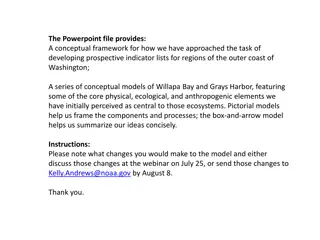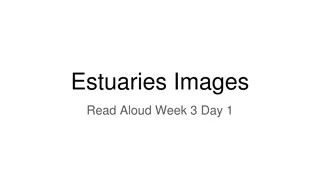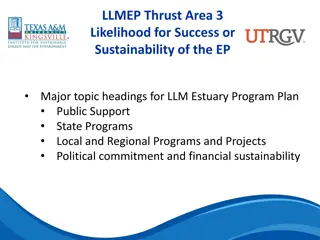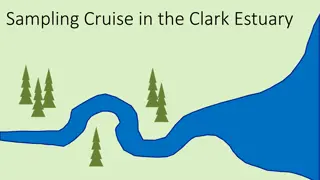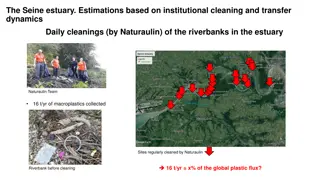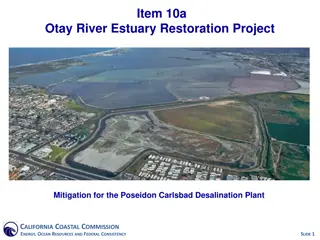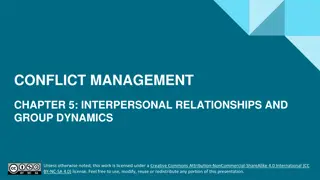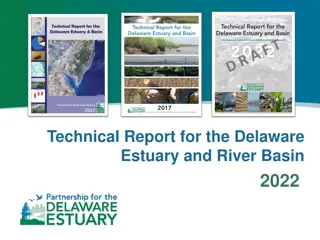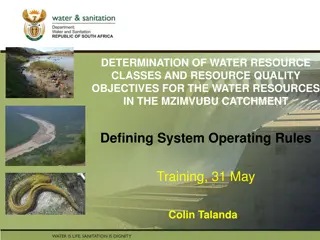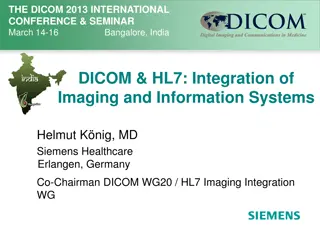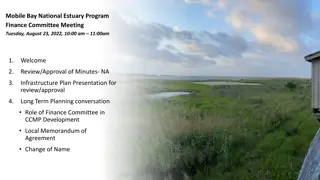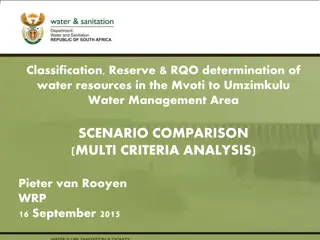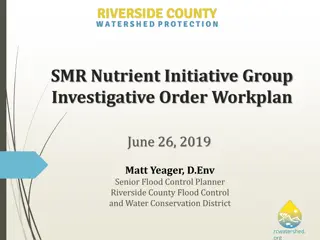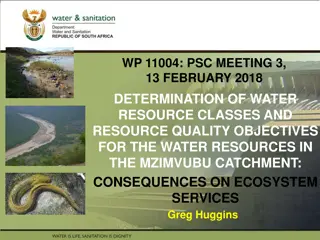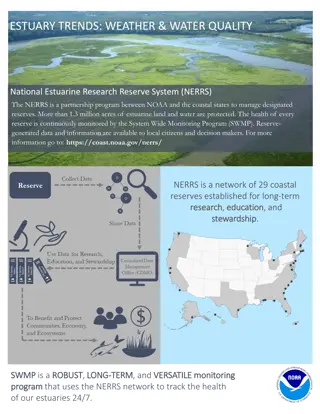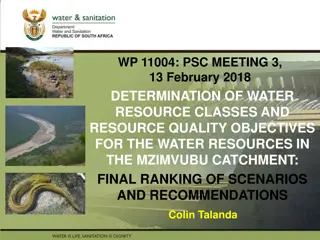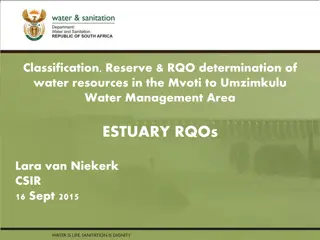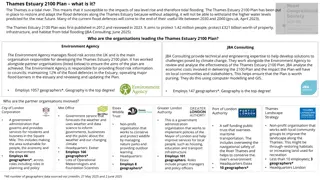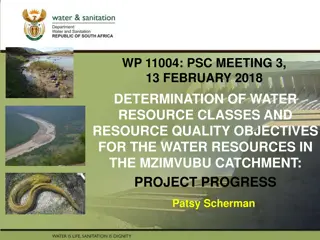
Water Resource Management in Mzimvubu Estuary
Determining water resource classes and quality objectives for the Mzimvubu Estuary, focusing on the estuary's ecological importance, delineation, and pressures. The estuary serves as a vital nursery and habitat for various marine species and plays a critical role in sediment and nutrient delivery to the marine environment. Efforts are needed to protect the estuary to meet biodiversity targets and address ecological challenges such as habitat destruction, invasive species, pollution, and overfishing.
Download Presentation

Please find below an Image/Link to download the presentation.
The content on the website is provided AS IS for your information and personal use only. It may not be sold, licensed, or shared on other websites without obtaining consent from the author. If you encounter any issues during the download, it is possible that the publisher has removed the file from their server.
You are allowed to download the files provided on this website for personal or commercial use, subject to the condition that they are used lawfully. All files are the property of their respective owners.
The content on the website is provided AS IS for your information and personal use only. It may not be sold, licensed, or shared on other websites without obtaining consent from the author.
E N D
Presentation Transcript
WP 11004: PSC MEETING 4, 15 MAY 2018 PRESENTATION TITLE DETERMINATION OF WATER RESOURCE CLASSES AND RESOURCE QUALITY OBJECTIVES FOR THE WATER RESOURCES IN THE MZIMVUBU CATCHMENT: ESTUARY RESOURCE QUALITY OBJECTIVES Susan Taljaard Presented by: Name Surname Directorate Date
MZIMVUBU ESTUARY DELINEATION Estuary functional zone (EFZ) defines geographical boundaries for estuaries, in the case of the Mzimvubu Estuary: Downstream boundary: Estuary mouth (31 37'52 S, 29 32'59 E) Upstream boundary: limits of tidal variation or salinity penetration, whichever penetrates furthest (31 29'7.15"S, 29 22'59.66"E) Lateral boundary: Sea Level along each bank as per Survey and Mapping (Mowbray) 5 m contour above Mean
MZIMVUBU ESTUARY RU Estuary freshwater dominated with minimal saline intrusion (although tidal variation extends to upper boundary
ESTUARY IMPORTANCE Ecological Importance: Highly Important WMA largely unregulated, one of few in region (i.e. no cross-basin transfers) Catchment supply high levels of ecological services nationally (SANBI undertaking economic importance assessment) Estuary used by Zambezi sharks as a pupping / nursery ground Nursery for White steenbras and Dusky kob - very limited suitable nursery habitat left in South Africa System plays significant role in delivery of sediments and nutrients/detritus to marine environment, nourishing local beaches and marine ecosystems Designated as priority estuary - needs protection to meet South Africa s biodiversity targets under National Estuarine Biodiversity Plan (NBA, 2011)
ESTUARY PES Ecological Category B Most of changes not as result of flow modification, but rather (non-flow related pressure) such as (some more difficult to remove): Habitat destruction Alien invasive plants Nutrient enrichment (pollution) Over-fishing Human disturbances to birds Larger scale removal of fish stock
TARGET ECOLOGICAL CATEGORY TEC: Category B~ PES and REC, but to maintain also require: Return some variability to mouth dynamics, e.g. remove access road currently entraining mouth ( First Beach ) Re-instate some sediment dynamics (as above) possibility resulting in re-establishment of beach at First Beach Institute land-use management regulation in EFZ zone to restrict loss of further habitat within EFZ, as well as floodplain (to +10 m MSL) Rehabilitate disturbed areas in EFZ (where possible) to enhance functional integrity and importance of system Establish Invasive Alien Plant Management Programme to enhance functional importance of floodplain areas Manage fishing pressure to protect important fish stocks and sensitive habitats (e.g. by considering partial closure) Address pollution risks, e.g. canalised creek flowing from Port St Johns
RESOURCE QUALITY OBJECTIVES (for TEC Category B) River inflow distribution not to vary more than 5% from Scenario 96 A/B Hydrology Estuary mouth not to close or become very constricted Changes in tidal amplitude (tidal gauge) < 20% from present baseline (2017) B Hydrodynamics Difference components) < 20% from that simulated for the present state (2017) (magnitude, timing and variability) in river inflow distribution patterns (flood Difference in suspended sediment concentration (river inflow) < 20% of sediment load-discharge relationship of present baseline (2017) Physical habitat (sediments) A Limited deviation in sedimentation and erosion patterns ( 0.5 m) from present baseline (2017) Deviation in median bed sediment diameter < factor of 2 from present baseline (2017) Deviation in sand/mud distribution (middle and upper reaches) <20% from present baseline (2017)
RESOURCE QUALITY OBJECTIVES (for TEC Category B) Salinity (lower reaches) > 20 at least 4-6 months Water quality (salinity) A/B Salinity (lower reaches) > 25 and (middle reaches) > 15 at least 1-2 months pH 7.0 - 8.5 DO > 6 mg/ Turbidity (naturally turbid system) Total metal concentrations in water not to exceed target values as per SA Water Quality Guidelines Total metal concentration in sediment not to exceed target values as per Western Indian Ocean Regional guidelines Water quality (other) C River: Dissolved Inorganic Nitrogen (DIN) < 200 g/ (monthly average) Dissolved Inorganic Phosphate (DIP) < 30 g/ (monthly average) Estuary: Dissolved Inorganic Nitrogen (DIN) < 150 g/ (average estuary) Dissolved Inorganic Phosphate (DIP) < 20 g/ (average estuary)
RESOURCE QUALITY OBJECTIVES (for TEC Category B) Maintain low phytoplankton biomass (average chlorophyll a < 20 g/ or median chlorophyll a < 3.5 g/ ) and a diversity of phytoplankton groups (cyanobacteria excluded). Maintain medium intertidal benthic microalgal biomass (median chlorophyll a < 23 mg/m2) C Microalgae No observable blooms and scums in the estuary Absence of cyanobacteria Maintaining diversity of macrophyte habitats as per present baseline (2017) Reeds and sedges covering maintained at ~16 ha. No more than 50% loss of reed and sedge habitats in non-flood year (e.g. linked to unfavourable salinity regime) C/D Macrophytes No increase in invasive species in riparian zone No colonisation main channel by sedimentation) vegetation (linked to
RESOURCE QUALITY OBJECTIVES (for TEC Category B) Maintain low-diversity invertebrate community with representation of present baseline (2017) freshwater, opportunistic taxa Maintain invertebrate community structured as per present baseline (2017) (defined by inherent physico-chemical drivers, e.g. salinity) A/B Invertebrates Maintain invertebrate community structured as per present baseline (2017) (linked to channel-like nature of estuary results with very few intertidal areas and soft sediments supporting only suitably specialised species)
RESOURCE QUALITY OBJECTIVES (for TEC Category B) Abundance of estuarine dependence category IIa species present as young juveniles in winter/spring/early summer (Solea bleekeri, Acanthopagrus vagus, Pomadasys commersonnii, Agyrosomus japonicus, Rhabdosargus holubi) - any one of these species not to be absent in system in two consecutive years Good trophic basis for predatory estuarine dependant marine species (most notably Agyrosomus japonicus and Pomadasys commersonnii), but not to occur abundantly in upper reaches B/C Fish Estuarine resident species core group present (Glossogobius spp., Oligolepis spp. Ambassis spp. and Gilchistella aestuaria) Oreochromis mossambicus not to extent into lower reaches for more than two consecutive years No alien species No decline in catches (Agyrosomus japonicus or Pomadasys commersonnii)
RESOURCE QUALITY OBJECTIVES (for TEC Category B) Maintain avifaunal community that includes representatives of all groups as per present baseline (2017) Tern roosts observed from time to time Number of water bird species recorded per count remains above 10 for 3 consecutive seasons C/D Birds Summer numbers of water birds (other than gulls and terns) remain above 50 for 3 consecutive seasons (A winter threshold should be determined once more data becomes available)

